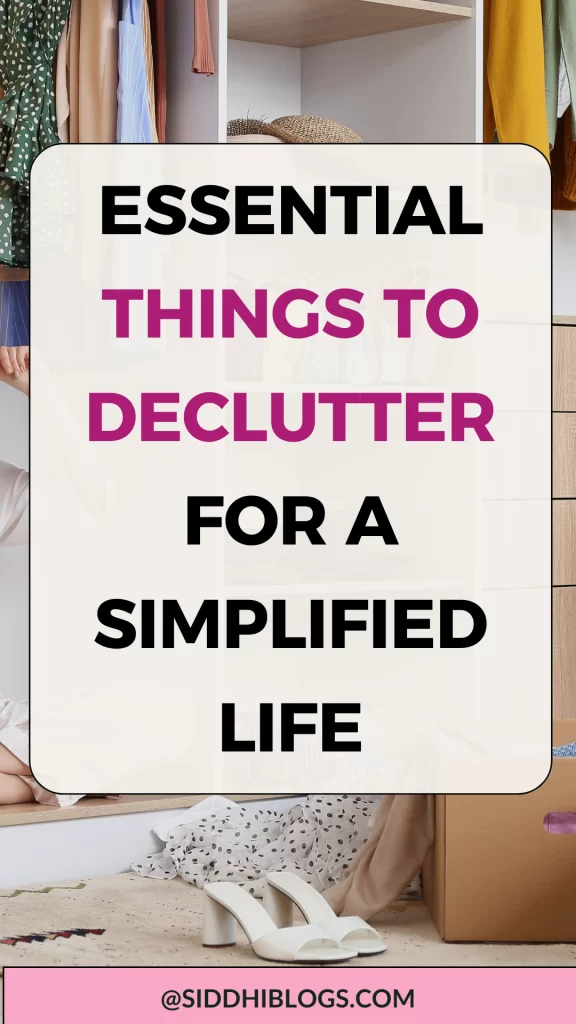Life is full of things we can’t control, but our home environment is something we can influence. Decluttering is a powerful way to have control of our surroundings and our feelings. But it’s not always easy to figure out things to declutter.
It can feel overwhelming especially when you are trapped in the cycle of just letting in stuff and holding on to it.
Decluttering is often misunderstood as getting rid of everything and embracing an extreme form of minimalism. But real decluttering is not about stripping your home bare, it’s about making intentional choices.
Benefits of Identifying Things to Declutter
Decluttering can have a surprisingly powerful impact on our mental health and overall well-being. When life feels overwhelming, sometimes the physical environment we live in contributes more to our stress levels than we realize.
But when you let go, you’re saying, “I choose to live for who I am now, not who I used to be, or who I might someday become.”
Choosing specific things to declutter literally lightens your load. The less you own, the less you have to clean, organize, and worry about.
Letting go of them helps you focus on more intangible priorities, things like:
- More time: With less to manage, you free up time for activities, experiences, and relationships that add richness to your life.
- Freedom and lightness: Owning less can give you a feeling of freedom—a sense that you’re not tied down by stuff and are more open to change.
- Mental clarity: A decluttered space leads to a decluttered mind, allowing you to be more present and thoughtful in your daily decisions.
- Living intentionally: By keeping only what resonates with you, you’re shaping your environment to support the life you truly want.
Why is it so hard to declutter?
If identifying things to declutter were easy, we’d all have neat and tidy homes. Here are some reasons why decluttering can feel daunting:
- Sentimental Attachment
We often attach deep meaning to objects. It’s not just a mug; it’s the mug your friend gave you during a tough time. Letting go can feel like losing a part of a memory or a piece of your identity. - Guilt Over Money Spent
Maybe you spent a small fortune on a gadget that’s now gathering dust, or bought a fancy dress you never wore. Getting rid of these things feels like admitting you wasted money. - Mindset of Just Clearing out stuff: When you view decluttering as the process of just discarding stuffs, it can be hard to figure out things to declutter. Shift your focus from getting rid of stuff to choosing what to keep. Approach each item with curiosity and ask, “Does this still serve me? Does it reflect who I am today?” This perspective helps you view decluttering as a positive, affirming process of selecting what adds value to your life, rather than just eliminating things.
- The “Just in Case” Mentality
We tend to hold onto items “just in case” we might need them someday. This mindset can lead us to hang onto broken appliances, outdated clothes, or duplicate items we never end up using. - Feeling Overwhelmed and Stuck
When you’re faced with a mountain of clutter, it’s hard to know where to start. The sheer volume can lead to decision paralysis, causing you to give up before you even begin. - Lack of Time and Help
Decluttering can be time-consuming, especially if you’re tackling it alone. It’s easy to push it off until “someday,” and that day never seems to come. - Fear of Missing Out: Hoarding culture can also be reinforced by social expectations. People keep things because they feel they should have a well-stocked home, be ready for guests, or display certain items to fit in socially. This pressure can lead to holding onto unnecessary items just to feel “prepared” or to meet a perceived standard. FOMO plays a part too—keeping things because of the fear that we might one day regret letting them go.
How to make decluttering easier?
When it feels hard to part with things you want to declutter, here are some how-to declutter strategies and declutter ideas that can make the process easier, helping you move towards a more intentional living environment.:
- I remind myself that the discomfort of letting go is temporary and manageable. After all, the short-term sting of parting with something is minor compared to the daily frustration and stress of a cluttered environment.
- I apply to let go with gratitude for items that I’ve used for a long time and for the role they played in my life. A simple “Thank you for serving me” transforms the decluttering into a process of appreciation.
- Make rules to simplify your life. Rules for mindful consumption. For every new item you bring into your home, let go of one that no longer serves a purpose.
- Don’t worry about what others might consider “too much” or “too little.” Keep what resonates with you, and let go of what doesn’t, regardless of how others might view it.
- When you have been putting off decluttering, planning and scheduling a day to declutter can be helpful.
- You can also use decluttering as a family activity when you are bored.
Having said that, I have been still holding on to stuff like my cat’s X-ray plate. Every time I consider it a thing to declutter, I look at those visual images of my cat’s bones and I keep it. I give myself permission to hold onto it until I am genuinely ready to let go.
Decluttering Checklist: Things to Declutter
Now that we know why it’s hard, let’s look at some practical things to declutter today.

1. Clothes You Never Wear
On of the top things to declutter are clothes we rarely use. There are probably items in your closet you haven’t touched in months—maybe even years. Holding on to clothing “just in case” is a surefire way to create a cluttered closet that makes getting dressed feel stressful.
What to do:
Sort through your wardrobe and be honest with yourself. If you haven’t worn it in the last 12 months, it’s time to part ways. Donate or sell it, and make space for the clothes you actually love and wear.
I have a yearly ritual of donating good to wear clothes to a local NGO. I feel lighter and happier too.
2. Paper Piles and Old Magazines
Paper clutter is one of the sneakiest sources of stress and another category of things to declutter. Old receipts, outdated bills, and those magazines you keep meaning to read can quickly pile up, making your desk or kitchen counter feel chaotic.
What to do:
Start by tackling one pile at a time. Sort your papers into “keep,” “shred,” and “recycle” categories. Keep only what you need for taxes or personal records. Consider switching to digital bills and storing important documents online to minimize future paper clutter.
3. Unused Kitchen Gadgets and Duplicate Tools
Have you ever tried to pull out a spatula only to have five other utensils come flying out of the drawer? It’s a sign that you have more kitchen gadgets than you need. We often buy new tools thinking they’ll make cooking easier, but end up using just a few trusty favorites.
The kitchen drawers may also be filled with unused spices, expired products, and empty containers you’ve thought you’d need it.
What to do:
Go through your drawers and cabinets and pick out gadgets you rarely (or never) use. Keep only what makes your life easier, and donate or sell the rest. This will free up space and make cooking more enjoyable.
4. Expired Beauty Products and Makeup
Like food, beauty products and makeup have expiration dates. Old makeup can harbor bacteria, and expired skincare products can lose their effectiveness. Plus, holding onto products you no longer use clutters up your bathroom, making it hard to find what you need.
What to do:
Check the dates on your products and toss anything that’s expired. If you have unopened items that you won’t use, see if a friend or family member could use them. Streamline your collection to only the products you love and actually use.
5. Books You’ve Already Read (or Won’t Read)
Books hold sentimental value, but they can quickly take over your living space. If your bookshelves are overflowing, it’s time to let go of those you don’t plan to read or won’t read again.
Books are items that I hoard but over time there’s not enough space to keep them. So, I donated 10-15 books (read and unread) to the local library a few months back.
What to do:
Be realistic about which books you’re likely to revisit. Donate, gift, or sell the ones that don’t make the cut. Keep a few cherished favorites, but give the rest a new home where they can be enjoyed by others.
6. Sentimental Items That No Longer Serve You
This might be one of the toughest categories. Maybe it’s a collection of knickknacks from past vacations or gifts from people you no longer keep in touch with. Sentimental items can tug at your heartstrings, making it difficult to decide what to keep.
What to do:
Ask yourself if the item brings you joy now, not just if it did in the past. Choose a few special pieces that represent meaningful memories, and let go of the rest. Remember: letting go of the physical item doesn’t erase the memory.
7. Old Electronics and Mystery Cables
That box of tangled cables and outdated tech in the corner? It’s not adding value to your life. Holding on to old electronics, broken gadgets, and random cables “just in case” often creates more chaos than utility.
What to do:
Go through and identify each item. If you don’t know what it belongs to, it’s probably not needed. Recycle old electronics responsibly and organize the cables you actually use.
8. Unfinished Projects
Are there half-done craft projects, untouched knitting supplies, or a scrapbook you planned to start years ago? Unfinished projects can create guilt and mental clutter every time you see them.
What to do:
Decide if you’re realistically going to finish it. If yes, schedule a time to work on it. If not, give yourself permission to let it go. Your time and mental space are valuable, and freeing yourself from these “should-dos” will feel like a weight lifted.
Other Miscellaneous Things to Consider Decluttering
- Craft kits, knitting yarn, paints, or model-making supplies that were part of an old hobby you’ve lost interest in.
- Loyalty cards for stores you no longer frequent, or coupons that are expired or for items you’ll never buy.
- Old files, screenshots, duplicates, and unused apps on your phone, tablet, or computer for digital decluttering.
- Containers with missing lids or warped bottoms that just don’t stack properly anymore.
- Half-empty or expired cleaning products that have been pushed to the back of your cabinet.
- Family keepsakes that hold no personal meaning but have been kept out of obligation.
- Old manuals and paperwork from electronics, appliances, or gadgets that have been discarded or upgraded.
- Magnets from old vacations, novelty magnets, or trinkets cluttering your junk drawer that don’t add value.
- Empty or outdated picture frames that are stored away and haven’t been displayed in years.
- Branded pens, keychains, and other freebies that you’ve accumulated but rarely use.
- Resistance bands, yoga mats, or sports gear that’s gathering dust because you’ve moved on to different exercise routines.
- Empty boxes from past online orders or electronics you no longer have, kept “just in case” you need them.
- Games with missing pieces or puzzles that have been sitting unfinished for ages.
- Décor that no longer fits your style or feels dated, such as vases, wall art, or figurines.
- Seasonal décor items that stay in storage year after year without making it into your decorating lineup.
- Old cables, chargers, adapters, and keyboards that are no longer compatible with any of your current devices.
- Souvenirs you bought out of impulse while traveling that don’t hold much sentimental value.
- Past years’ planners or wall calendars you’ve been keeping “for memories,” but never actually reference.
- Bins or boxes under your bed with items you haven’t accessed in years—time to reassess!
- Old birthday cards, wedding invitations, and holiday greetings that aren’t particularly meaningful.
- Hair accessories that are past their prime or don’t match your current style.
- Power cords and charging cables that belong to outdated phones, cameras, or gadgets you no longer use.
- Mismatched socks and undergarments that are no longer in good condition but somehow remain in the drawer.
- Business cards from people or companies you no longer have a connection with.
- Trinkets or novelty items you received as gifts that you keep out of guilt rather than enjoyment.
- Old event programs or playbills from performances you attended long ago but rarely revisit.
- Leashes, toys, or bedding or products your current pet no longer uses.
- Pens, markers, highlighters, or notepads that are dried up or excessive in number.
- Small bottles of shampoo, soap, or lotion you’ve collected from hotels but never use.
- Consider “decluttering” limiting beliefs, old habits, or mental scripts that no longer serve you. This isn’t physical clutter, but it can weigh you down just as much!
It’s easy to accumulate things over time, and even if we don’t think much of it day-to-day, all that clutter can quietly weigh on us. A home filled with excess stuff can become overwhelming, making it harder to stay organized and find what we actually need.
But it’s also understandable why letting go of things is hard! Many of us attach emotional value to our possessions or feel guilty for getting rid of something we spent good money on. So, it’s a gradual process—letting go little by little, creating a home that feels lighter, more intentional, and a place where you can truly relax.
You can also Read:
- Habits to Help You Stay Organized
- A Decluttering Guide to Help You Get Organized
- How to Plan Your Day Better



